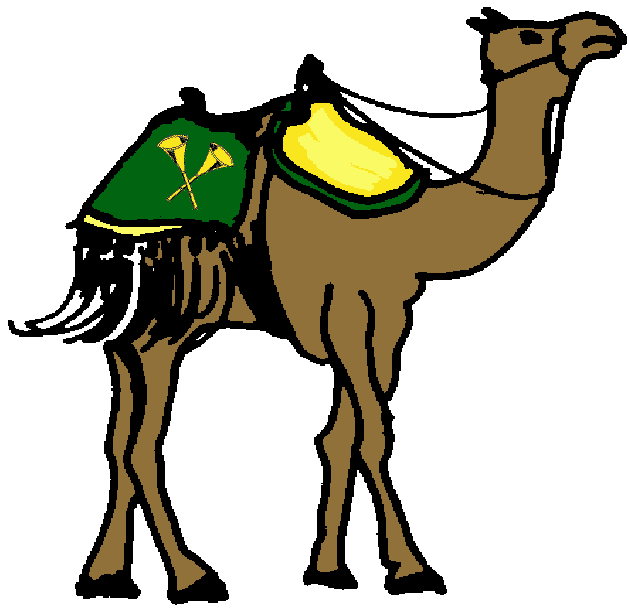
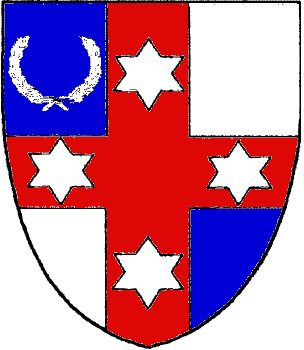
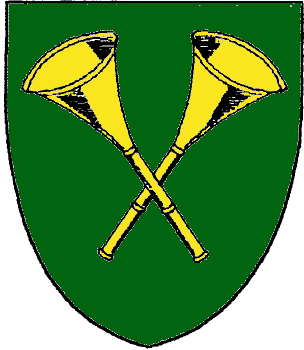
Crux Australis Herald
Lord Uberto Renaldi [mka Nigel Castle]
GPO Box 2719, Adelaide SA 5001, Australia
phone: (08) 8336 6791 or intl +618 8336 6791
 |
Crux Australis Herald Lord Uberto Renaldi [mka Nigel Castle] GPO Box 2719, Adelaide SA 5001, Australia phone: (08) 8336 6791 or intl +618 8336 6791 |
"The CAMeL"
November 1999 (A.S. XXXIV)
Unto the College of Heralds of the Principality of Lochac, and all others who may read this missive, from Lord Uberto Renaldi, Crux Australis Herald, greetings!
In this issue…..
Introduction | News from the BoD | November Coronet | Twelfth Night | Reports
Roster changes | Important addresses | Subscriptions and Resources | Submission requirements
Meeting schedule | Recent submissions | News of previous submissions
Welcome to another Camel. I have been spending a good deal of time familiarising myself with the Crux files and, despite a ten-day break in Queensland, I feel that I am getting on top of things. Thank you to all those who wrote to congratulate (and commiserate) me on my accession.
Of course, I am but one cog of many in the great machine that makes up the College – my job is to keep everything running smoothly either by applying grease or the occasional whack (not literally, of course)!
The important people are those doing the real work: heralding at tourneys and feasts, conducting courts and assisting the populace with name and device submissions. Ultimately, I am here to serve and support, so please do not hesitate to contact me with any queries or problems.
News from the Board of Directors (the “BoD”)
Back in April the Board of Directors made a change to Corpora (the document that defines the medieval structure of the Society) such that the office of Herald is no longer required for branches below Barony level (ie Shires, Cantons and Colleges) so long as the branch has either a Marshall or A&S Minister as well as a Seneschal and an Exchequer.
Although the BoD have not published this change yet in Tournaments Illuminated (the Society's official publication) as far as I can tell it nonetheless has been in effect since the board meeting at which Corpora was changed.
What does this mean for the College of Heralds? It may mean a great deal of extra work for the Baronial Heralds, who would have to pick up the work for the Cantons and Colleges within their Barony without heralds. On the positive side, seneschals of smaller groups will be relieved of the hair-pulling task of finding someone in their group to be herald (whether they have an interest in heraldry or not) just to keep the group “official”.
There are no doubt many other implications. I urge all group heralds to discuss this change with your seneschal and (if you are part of a Barony) your Baron and Baroness, and bring along or send me your thoughts for discussion at Twelfth Night (see below).
A big thank-you to all those who assisted. I have not received a list of names, but you know who you are.
I will be holding a heralds' meeting at Twelfth Night, mainly to discuss the changes to Corpora mentioned above, but also to meet as many of you who can attend and to hear first-hand any problems or suggestions you may have, and answer any of your queries.
If you cannot attend but have an issue you would like discussed then please forward it to me in writing so that it is in my hands at least a week before the event.
I have yet to decide whether this gathering should be called a Council, a Synod or a Diet – preferences, please!
I have received reports from the Heralds of Torlyon, Innilgard, River Haven, Saint Augustine, Saint Monica, Drakkars Fjord, Dismal Fogs, Parvus Portus and Aneala, and one from Gwynfor Lwyd on his activities as a Pursuivant-at-large. The Herald of Bacchus Woods has reported via Aquarius Pursuivant.
I would remind all group heralds that it is a requirement of your office to report quarterly; either directly to me if you are a Baronial or Shire Herald, or through your Baronial or Shire Herald if you are herald for a Canton or College. All group heralds should also send a courtesy copy of each report to their Seneschal and Baronial Heralds should cc: their Baron and Baroness. I will not object to Canton and College Heralds sending me a copy of their reports.
Following the ruling by the BoD in April (see above) I will have no hesitation about firing Canton and College Heralds who have not reported for more than six months. Shire and Baronial Heralds who are similarly lax can expect stern letters (cc'ed to their seneschal), and will be suspended from office after nine months of silence.
This may sound somewhat harsh, but I do not believe that it is too much to ask anyone to put pen to paper every three to six months. Reports do not have to be anything fancy – just a summary of the heraldic activity in your group over the past few months showing number of submissions, who is doing heraldic work (consulting, field and court), any problems encountered, and anything else you think I should be aware of.
Due date for next reports: Last issue I asked for reports by 7th January 2000. However, since then I have re-read the Laws of Lochac which state that I must have a report to Their Highnesses at least four weeks before Investiture, so I am now asking for end-of-reign reports to be in my hands by Saturday 11th December 1999. If you didn't get a report to me for the previous quarter then here is your chance to redeem yourself!
Master Gwynfor Lwyd, previously a Pursuivant at Large, has volunteered for the position of Mortar Pursuivant, the deputy for all matters regarding voice and field heraldry. Welcome to your new position in the College, Master Gwynfor, and may you soon have the heralds of Lochac sounding as sweet as angels!
“The CAMeL” is available from Crux Australis at $20 per year. Make cheques payable to "SCA Inc. College of Heralds". Alternatively, get it for free from “http://www.sca.org.au/herald”.
Laurel's Letter of Acceptance and Return is available from the SCA College of Arms. Send a cheque for $US25 made out to “SCA Inc. – College of Arms” to Bruce R. Nevins, 2527 E. 3rd Street, Tucson AZ, 85716-4114, USA. As usual, everything of relevance to Lochac will be published in “The CAMeL”.
Master Thorfinn is the person to talk to about heraldic publications. Possibly the most useful item that he stocks is the `Heraldic Pictorial Dictionary for the SCA' (affectionately known as the PicDic), which will cost you $A8.50 for the first edition or $A12.50 for the second edition. Alternatively, order it directly from the USA via Free Trumpet Press for $US15 (details of their web site are below – and they now take credit cards).
I also recommend that groups acquire some name resources, in particular P.H. Reaney & R.M. Wilson's `A Dictionary of English Surnames' and E.G. Withycombe's `The Oxford Dictionary of English Christian Names'.
The Crux Australis web page at http://www.sca.org.au/herald contains useful information for heralds, and links to the SCA Heraldry page, and other general SCA pages. If you have web access, I recommend that you take a look.
Many interesting heraldic links can be found through the SCA Heraldry web page at http://www.sca.org/heraldry including the Laurel home page, on-line armorial and ordinary search, and the Academy of St. Gabriel (an heraldic consultation service). The Free Trumpet Press West web page is http://www.sca.org/heraldry/ftpw or email klconlin@ilstu.edu
Cost: $20 per new submission (name, device or badge). No cost for resubmissions or branch submissions. Make cheques payable to "SCA Inc College of Heralds".
Copies required for submissions:
Please check that submitters have ALL necessary documentation to support each submission. Remember, they have to present their submission in a way that makes registration easy. Name documentation should be as accurate as possible, and photocopies supplied unless the reference is a standard one such as Reaney or Withycombe. Even then, the page number(s) and edition should be quoted.
Crux Australis Herald holds a meeting at least once a month to consider submissions, which are then either forwarded to the College of Arms for commentary (and hopefully registration), or returned (if we find a conflict or a stylistic problem) or, occasionally, pended awaiting clarification from the submittor. If we have the time and enthusiasm, we may also look at and comment on submissions from other Kingdoms.
Crux meetings are usually held at 36 Rosella Street, Payneham SA, starting at 2pm. Please call (08) 8336 6791 or Email ncastle@tplex.com.au beforehand if you intend to bring submissions for processing. The next meetings are scheduled for Sunday 19 December 1999 and Sunday 23 January 2000.
Thorfinn Hrolfsson, Hund Herald, also holds regular commentary meetings in Melbourne. Please call him for details on (03) 9885 6348.
Present at the Crux Australis meeting held on Sunday 21st November 1999 was Lord Uberto Renaldi, Crux Australis Herald, on his lonesome! <sob>
The following items were SUBMITTED to Laurel Queen of Arms for registering:
1. Alycie Stirling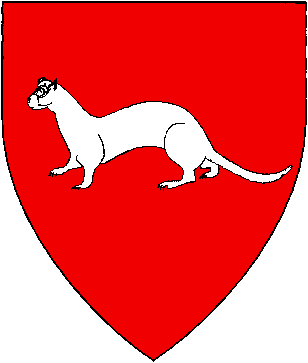
New Device
Group: Innilgard
Consulting herald: William Forrestor de Blackwode
Gules, a ferret statant argent.
The submittor's name was registered by Laurel in July 1999. The device appears clear of (Fieldless) A stoat statant guardant proper (Device for Riley of Golden Sand, March 1988) as “proper” colouring for a stoat is presumably brown (although they usually turn white in winter).
2. Crispin Sexi
New Name (see RETURNS for device)
Group: Politarchopolis
Consulting herald: Sigmund Spelmann
The submittor would like an 11th – 14th century male English name. He will accept minor changes, and cares most about the sound of the name.
“Crispin” is found in Whithycombe on page 72, where it is mentioned as having been used in the Middle Ages. “Sexi” is documented from Reaney (p402) under “Sexy” as derived from Old Norse – a “John Sexi” was known to have been alive circa 1210. As the OED dates the first usage of the word (in its modern meaning) to 1925, I would be very interested to learn what it meant (if anything) pre-1600!
3. Dai Bach 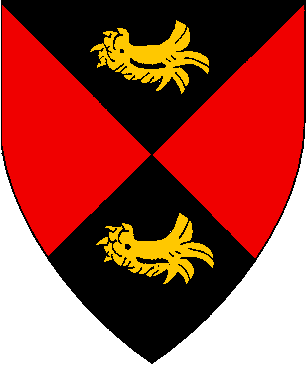
New Name and Device
Group: Innilgard
Consulting herald: William Forrestor de Blackwode
Per saltire sable and gules, in pale on the sable quarters two lion's jambes erased fesswise Or.
The submittor desires a male Welsh name. He will accept major changes, the important aspect being the language and/or culture.
“Dai”, according to Heather R. Jones (via SCA Heralds email list), is a Welsh pet-form of the name David or Dafydd and appeared in Welsh legal documents from the 13th century onwards. “Bach” is a Welsh byname based on a descriptive nickname, in this case meaning “small” according to Jones' website.
The device appears free of conflict. I am not aware of any other way of blazoning the device to indicate that the lion's jambes are only the sable portions of the field. It is possible that an artist working from the blazon Per saltire sable and gules, in two lion's jambes erased fesswise Or could draw the jambes much larger, thereby making them cross the line of division. The arrangement of the charges on the submitted emblazon would only be obvious if the field consisted of Per saltire sable and Or, forcing them to remain on the sable parts of the field. Hopefully, the College of Arms can find a more elegant blazon.
4. Robert of Strathconan 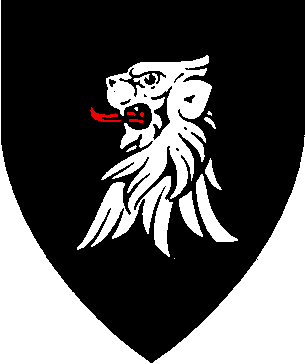
New Name and Device
Group: Innilgard
Consulting herald: William Forrestor de Blackwode
Sable, a lion's head erased argent langued gules.
The submittor would like a male name and will accept major changes (no other criteria were selected).
“Robert” is found in Withycombe on page 254 (and really doesn't require much documenting as a period Scottish name). “Strathconan” is mentioned by Warner (p83) as one of the lands included in a royal charter of 1476, and the same evidence is given by Dunlop (p7).
The strikingly simple device appears free of conflict.
5. Yevan of Leeds
New Name
Group: Innilgard
Consulting herald: William Forrestor de Blackwode
The submittor desires a male English name. He will accept major changes and cares most about the meaning and the language/culture.
“Yevan” is found in Withycombe on pages 112-3 as an earlier, Middle English form of “Evan”. According to Mills (p208), there are two places named “Leeds” in England: one in Kent first mentioned in 1086 CE (in the Domesday Book) as “Hledes” and one in West Yorkshire first mentioned in 731 CE as “Loidis” and later in the Domesday Book as “Ledes”. As the submittor did not specify a preferred time-period for the name, I have left it as submitted as I do not know when Leeds acquired its current spelling.
The following items have been RETURNED for further work:
1. Crispin Sexi 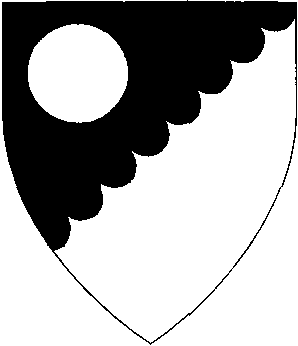
New Device
Per bend sinister engrailed sable and argent, a roundel argent.
The device was found to conflict with Per bend sinister sable and gules, a plate (Badge for Erryk Blackwolf, registered June 1973). Unless you are comparing to devices which have no charges then you can only count one CD for all changes to the field (RfS X.4.a.i). The change in position of the roundel (from centred on the shield to dexter chief) does not give a CD as it is an arrangement forced by the design (RfS X.4.g). That is , in the submitted device the roundel could not be central as half of it would then be invisible (argent on argent).
For the same reasons it is also in conflict with Purpure mulletty Or, a moon in her plenitude argent (Device for Heather MakKinzie or Weir, registered November 1995) and Per pale sable mulletty of eight points argent and purpure, a moon in her complement argent (Device for Aurora Gillybary, registered October 1993).
[Note: A plate is another term for a roundel argent. A moon in her plenitude or complement is a roundel with a human face on it, and is heraldically identical to a roundel.]
2. Madeleine du Lac d'Agenais
New Name (New Device PENDED)
Group: Politarchopolis
Consulting herald: Sigmund Spelmann
The submittor wishes for a female French name from the 14th – 16th centuries. She will accept minor changes, and considers both the sound and the language/culture important.
The documentation provided (Dunkling, p177) lists “Madeleine” as the French form of “Magdalen(e)” which came into use in English-speaking countries in the 1930s. The name “Magdalene” was introduced to the U.K. from France in the Middle Ages.
Unfortunately, this is not sufficient proof that “Madeleine” was used in France during the SCA's period of interest. Although I have no doubt that it is a perfectly acceptable name, without documentation to show this I cannot forward the submission to the College of Arms for registration. It is up to the submittor (with help from their consulting herald) to provide documentation that supports their submission. Although I will help where I can, in this case I could not – a brief search through the Crux library discovered nothing of use. The rest of the name, “du Lac d'Agenais”, appears fine and is sufficiently documented.
A device was also submitted, but it cannot be processed without a name and so has been pended.
References
Dunkling, Leslie and Gosling, William, `Everyman's Dictionary of First Names', 3rd edition, Guernsey Press Co. Ltd., 1991.
Dunlop, Jean, `The Clan MacKenzie', W. & A.K. Johnston and G.W. Bacon Ltd., 1953.
Mills, A.D., `A Dictionary of English Place Names', Oxford University Press, 1991.
Jones, Heather R., `A Simple Guide to Constructing 13th Century Welsh Names', http://www.panix.com/~mittle/names/tangwytyl/welsh13.html, 1996.
Reaney, P.H. and Wilson, R.M., `A Dictionary of English Surnames', 3rd edition, Routledge London 1991.
Warner, Gerald, `Homelands of the Clans', Collins, 1980.
Withycombe, E.G., `The Oxford Dictionary of English Christian Names', 2nd edition, Oxford University Press, 1959.
From the LoAR dated August 1999
ACCEPTANCES
Catigern Goch. Name and device.
Sable a frauenadler displayed Or crined purpure and a tierce bendy sinister Or and purpure.
Submitted as Catigern y Goch, the definite article was dropped to reflect period practice.
Conan MacAindreis. Name (see RETURNS for device).
Nicolette de Coulours. Name and device.
Quarterly purpure and vert, a hippogriff segreant Or.
Ulfrikr inn Hrafn. Device.
Paly bendy argent and sable, an eagle's wing fesswise terminating on the dexter side in a hand sustaining a sword gules.
RETURNS
Conan MacAindreis. Device.
Gules a sword quillioned of balance pans argent, a bordure argent ermined gules.
The sword in this design looks like a part of a balance and not like a sword. Therefore this is returned for violating rule VIII.3, Armorial Identifiability.
Drakkarfjord, Canton of. Name and device.
Gules a drakkar Or, the sail charged with a laurel wreath vert and a base barry wavy of four argent and azure.
We are returning the name because the word drakkar has not been documented as a Norse (or any Scandinavian) word. It appears that the word was not used in period.
Lind (Norsk-Isl”ndska Personinamn frÂn Medeltiden, col. 202) shows the late medieval personal name Draki with a genitive form Draks so Draksfjord looks to be a likely name. The device must be returned as holding names cannot be created for groups.
Wilfred de Ackelonde. Device.
Checky sable and argent, a dragon rampant gules.
This device conflicts with the Free Company of Mariners (Bela of Eastmarch), Gyronny sable and argent, a dragon rampant gules, armed and webbed vert. There is one CD for field but nothing for arming or webbing.